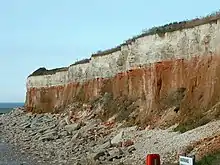Hunstanton Cliffs
Hunstanton Cliffs is a 4.6-hectare (11-acre) biological and geological Site of Special Scientific Interest in Hunstanton in Norfolk.[1][2] It is a Geological Conservation Review site.[3][4]
| Site of Special Scientific Interest | |
 | |
| Area of Search | Norfolk |
|---|---|
| Grid reference | TF 676 420[1] |
| Interest | Biological Geological |
| Area | 4.6 hectares (11 acres)[1] |
| Notification | 1984[1] |
| Location map | Magic Map |
These eroding cliffs expose a mid-Cretaceous sequence from the Albian to the succeeding Cenomanian around 100 million years ago, with exceptionally rich Albian ammonite fossils. Biological interest is provided by a colony of breeding fulmars on the cliff face.[5]
There is public access to the beach.
| Wikimedia Commons has media related to Hunstanton cliffs. |
References
- "Designated Sites View: Hunstanton Cliffs". Sites of Special Scientific Interest. Natural England. Retrieved 12 June 2018.
- "Map of Hunstanton Cliffs". Sites of Special Scientific Interest. Natural England. Retrieved 12 June 2018.
- "Hunstanton Cliffs (Cenomanian, Turonian, Senonian, Maastrichtian)". Geological Conservation Review. Joint Nature Conservation Committee. Retrieved 25 May 2018.
- "Hunstanton Cliffs (Aptian-Albian)". Geological Conservation Review. Joint Nature Conservation Committee. Retrieved 25 May 2018.
- "Hunstanton Cliffs citation" (PDF). Sites of Special Scientific Interest. Natural England. Retrieved 12 June 2018.
This article is issued from Wikipedia. The text is licensed under Creative Commons - Attribution - Sharealike. Additional terms may apply for the media files.